Thought You Guys Might Enjoy My Intro to Chemistry Cheat Sheet
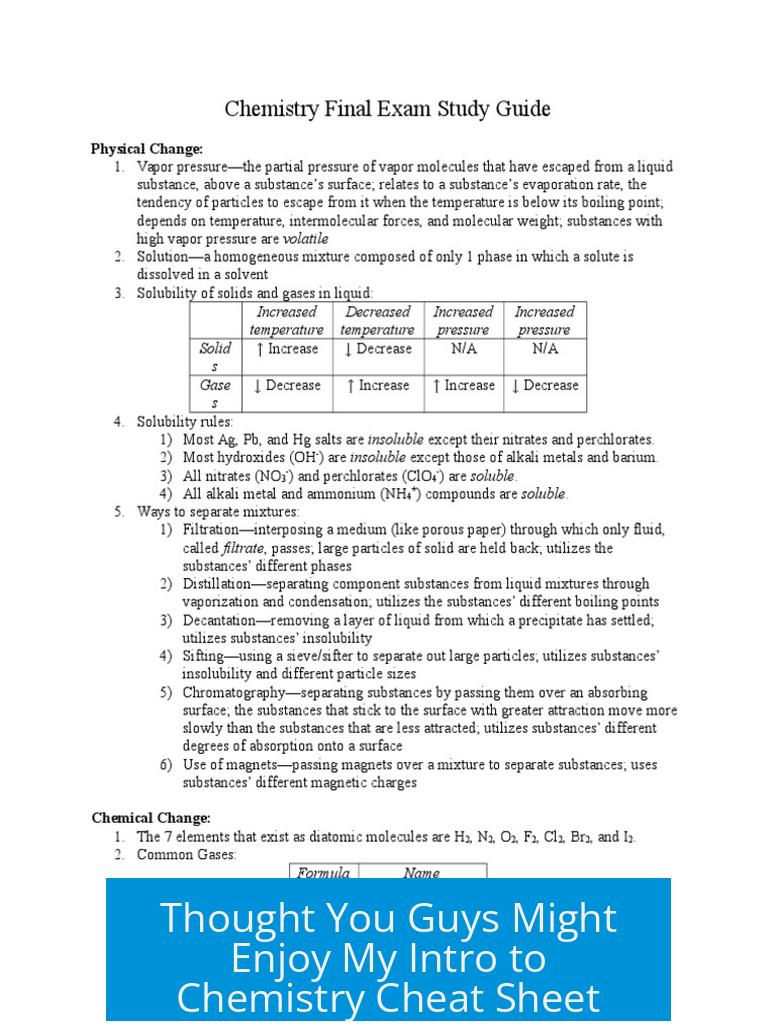
This cheat sheet summarizes essential concepts and tips for introductory chemistry. It clarifies common misconceptions, reinforces proper notation and units, and encourages deep understanding over rote memorization. From molar mass to algebraic manipulation and study advice, the content addresses typical beginner challenges.
1. Molar Mass and Units
Molar mass is a foundational idea in chemistry. It relates a substance’s mass to the amount of material in moles. The correct symbol for molar mass is M. It should never be written as “mm” because that stands for millimeters, a spatial unit unrelated to chemistry.
The units of molar mass are always grams per mole (g/mol). Using just grams is incorrect. For example, water has a molar mass close to 18 g/mol. This means one mole of water weighs about 18 grams.
Proper notation and units are essential for dimensional analysis. Incorrect units can cause formula errors and confuse calculations. Always represent molar mass with “M” and units as “g/mol” to maintain clarity and correctness in chemical equations.
2. Algebra, Formula Manipulation, and Understanding
Algebra is critical to chemistry problem solving. Many chemical formulas are simple expressions relating different variables. For instance, a formula like A = B × C can be rearranged algebraically to solve for any variable.
Students should practice transforming formulas by isolating unknowns rather than plugging in numbers blindly. This approach fosters a better grasp of relationships and units in chemistry problems.
- Example: Starting with mass (m) = moles (n) × molar mass (M), you can find moles by n = m ÷ M.
- Understanding unit cancellation helps verify formula correctness.
- Presto: algebra makes complex relationships manageable.
Relying on algebraic skills rather than memorization ensures students adapt to novel problems. A strong algebraic foundation is as important as chemical knowledge.
3. Standard Conditions and Constants
Standard conditions in chemistry describe temperature and pressure for measurements like gas volumes. Common terms include STP (Standard Temperature and Pressure) and NTP (Normal Temperature and Pressure).
The term SLC is less common and can lead to confusion unless clearly defined. It’s often better to state conditions precisely, such as:
- Temperature: 0°C (273.15 K) or 25°C (298.15 K)
- Pressure: 1 atm or 1 bar
The ideal gas law pV = nRT is fundamental for calculating gas properties under varying conditions. Students should understand and apply this equation to derive molar volumes.
Explicitly writing out standard conditions and formulas avoids ambiguity. It also prepares learners to solve problems flexibly using core thermodynamic principles.
4. Chemical Symbols and Variables: m, n, M, C, V
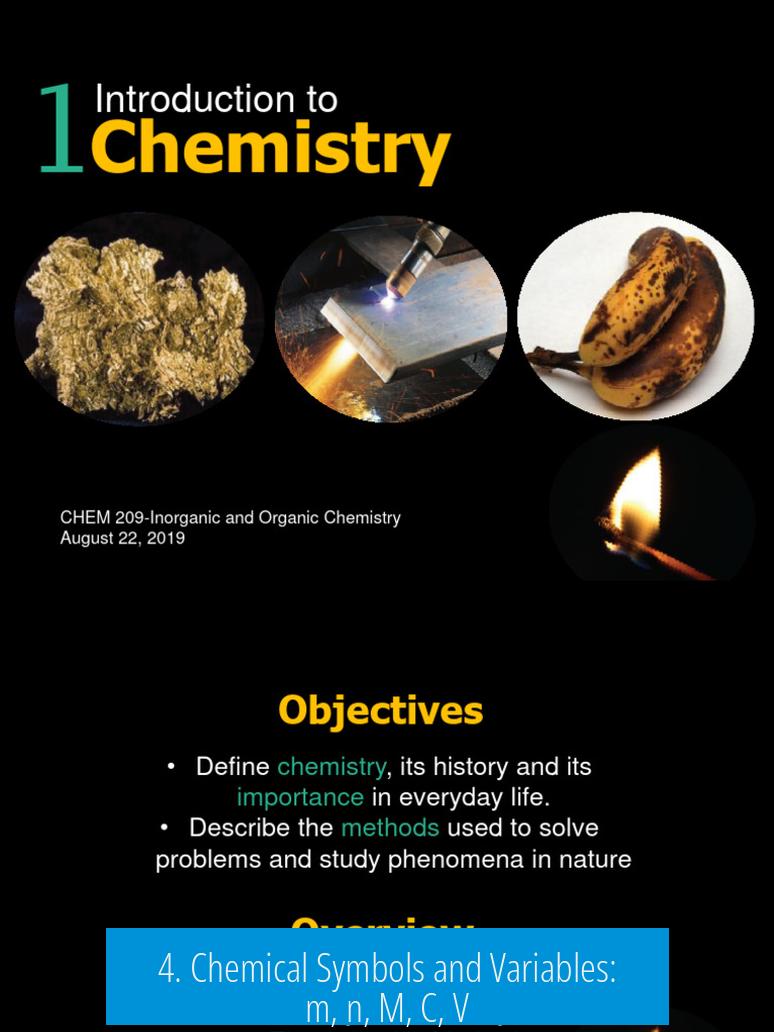
Several variables repeatedly appear in introductory chemistry:
| Symbol | Meaning | Units / Notes |
|---|---|---|
| m | Mass | grams (g) |
| n | Moles | mol |
| M | Molar Mass | g/mol |
| C | Concentration | mol/L (molarity) |
| V | Volume | liters (L) |
Mnemonics help in retaining relationships. Many use triangular diagrams placing m, n, M or C, V, n at vertices. Hide the unknown variable to visualize the formula.
- For example, from m = n × M, hide m, so n = m ÷ M or M = m ÷ n.
- Similarly, for dilutions, C1V1 = C2V2 represents concentration-volume balance.
There is debate over using “C” versus “M” for concentration variables. “C” is preferred as it represents concentration generally, while “M” can create confusion with molar mass. Consistency in symbols aids clarity.
5. Study Tips and Encouragement
Creating and organizing a cheat sheet develops a valuable skill. It encourages students to consolidate knowledge and provides quick reference during study.
Experts recommend internalizing concepts rather than just memorizing formulas. Practice with problems helps transfer this knowledge from paper to intuition.
- Revisit the content regularly to build fluency in chemical symbols and equations.
- Use unit analysis as a constant checkpoint in problem solving.
- Recognize that older chemistry knowledge fades but practice aids recuperation.
Learning chemistry starts slowly but gains momentum. Confidence grows when core concepts become second nature.
6. Critique and Suggestions for Improvement
Some users find basic cheat sheets too elementary or cluttered by white space. Clarity improves when content is concise and algebraically simplified.
Introductory classes sometimes mix topics poorly, e.g., introducing organic chemistry reactions too early. A clear syllabus progression benefits learners.
Ultimately, the goal is to internalize processes, not rely on external aids. A cheat sheet is a learning tool, not a crutch.
7. Miscellaneous Comments
Memorizing universal constants, like Avogadro’s number (6.022 × 1023), remains important but is more meaningful with contextual understanding.
Preferences in notation, such as using liters (L) versus cubic decimeters (dm3), vary but should be consistent within one’s work.
Friendly humor and communal sharing of cheat sheets foster a positive learning atmosphere.
Summary of Key Points
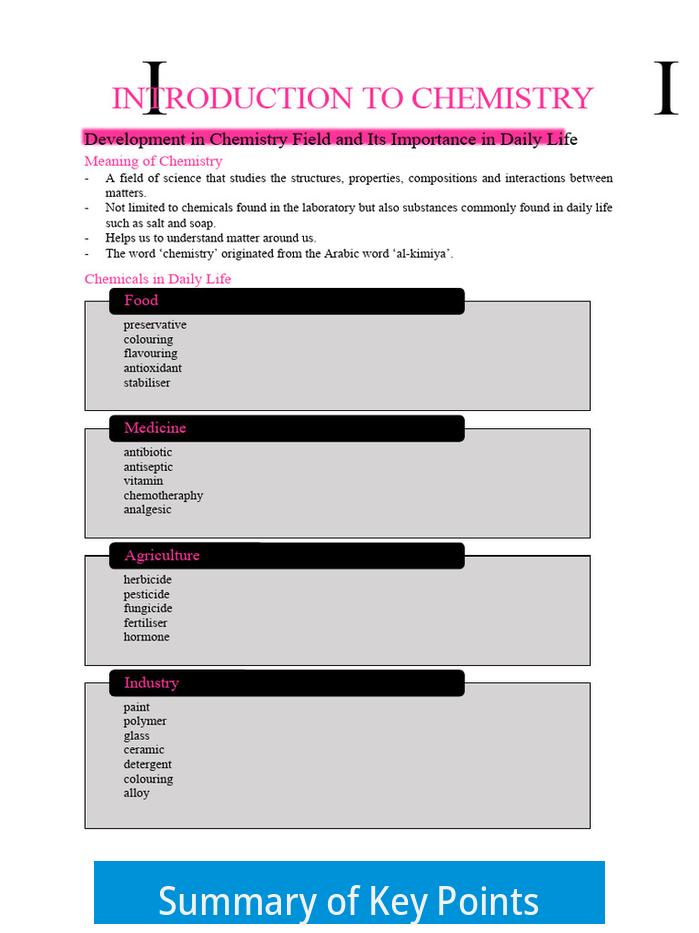
- Use proper notation: M for molar mass, g/mol as units.
- Master algebra: Rearrange formulas to isolate unknowns.
- State standards clearly: Define temperature and pressure explicitly.
- Understand variables: Recognize roles of m, n, M, C, and V in chemistry formulas.
- Internalize formulas: Practice unit analysis and problem solving to build intuition.
- Make cheat sheets skillful: Use them as memory tools, not substitutes for learning.
Thought You Guys Might Enjoy My Intro to Chemistry Cheat Sheet
Ever wished chemistry had a cheat sheet that’s actually helpful? Here it is! This intro to chemistry cheat sheet breaks down essentials like molar mass, formula manipulation, and standard conditions. It’s packed with tips that make messy formulas more manageable—and understandable. Whether you’re drowning in symbols or just trying to pass that next test, this guide’s got your back.
Clear Up the Confusion: Molar Mass and Units
First things first, the correct symbol for molar mass is M, NOT “mm”. That little slip trips up many beginners. “mm” actually means millimeters—distance, not mass! Keep M for molar mass, please. Also, pay attention to the units: molar mass isn’t just “grams.” It’s grams per mole (g/mol). This is crucial. Using grams alone breaks your formula’s sense and messes up unit analysis.
Proper symbol use might feel picky, but it saves headaches. You want your formula to make dimensional sense; otherwise, you’re playing a chemistry guessing game. Trust the cheat sheet advice here: memorize “M” and “g/mol” early on—it’ll feel second nature within months.
The Magic of Algebra in Chemistry
Sound math skills aren’t just for math class. In chemistry, being comfortable with algebra is a superpower. Manipulating formulas to isolate unknowns saves loads of time and confusion.
Take the formula like A = B × C. If you need to find B, rearranging gives B = A / C. This basic skill clears tangled formulas instantly. The cheat sheet nudges you to understand what formulas do, not just plug numbers blindly. Unit cancellation is part of this magic—cancel the units on top and bottom until the answer’s unit matches what you expect. It’s like chemistry’s version of tidying your room.
One former TA points out that the moral of freshman chemistry isn’t just formulas, it’s “units, units, and more units.” This cheat sheet agrees; your best friend is unit analysis, so don’t skip it!
Standard Conditions and Why They Matter
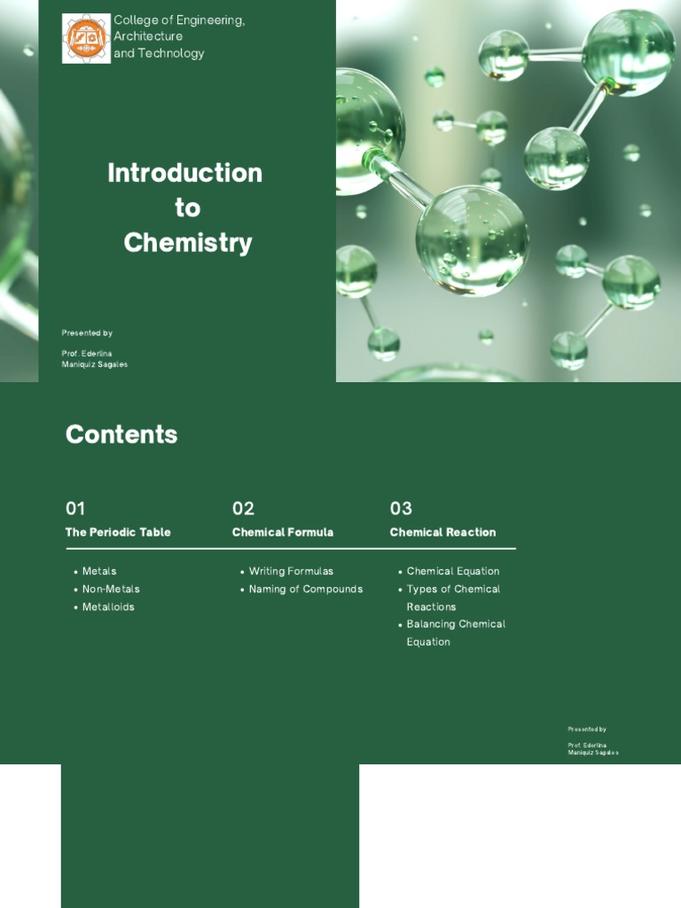
Look, questions about what “SLC” means are common. Most beginners hear about STP (Standard Temperature and Pressure) or NTP (Normal Temperature and Pressure). But SLC? Less common. The takeaway is: always state your standard conditions explicitly—temperature, pressure, concentration—don’t just rely on shorthand or derivations.
The cheat sheet reminds you that the ideal gas law (pV = nRT) is fundamental. You’ll likely need it for deriving molar volumes or predicting gas behavior. It’s a quarter of general chemistry for a reason. Skipping it is like trying to bake without measuring cups.
Chemical Symbols: More Than Just Letters
Confused by the letters m, n, MM, C, and V? Here’s a colorful cheat to keep them straight: imagine arranging m, n, and MM in a triangle—hide the unknown, then solve for the missing piece.
Similar tricks work with N, c, and V. Instead of drowning in definitions, think formula triangles. The cheat sheet also opts for using C over molarity (M) when referencing concentration because it feels cleaner. Plus, formulas like C1V1 = C2V2 neatly describe dilutions.
Forget the confusing mix of volume symbols (L or dm3). Be consistent: C1V1 = C2V2 is straightforward and makes your life easier.
Study Tips That Actually Work
Let’s get real—chemistry isn’t easy. But organizing a cheat sheet? That’s a life skill! One user applauds the effort, noting that “this info will be second nature to you within a year.” Another chimed in, “My chemistry test is on Wednesday—I kind of love you OP.”
What’s the secret? Don’t just memorize—internalize what each formula means and how the units align. Practice lots of problems. The more you work with the material, the easier it becomes. The cheat sheet supports this approach, serving as a compact reminder, not a crutch.
Some Critiques: Keep It Simple and Concise
Not everyone loves a big cheat sheet. Some readers find it a bit basic or full of too much white space. Others joke, “I understand like a quarter of this lmao,” highlighting the vast gap beginners face.
One suggestion is to focus on concise formulas with algebraic manipulation instead of lengthy explanations. It’s better to master converting formulas than memorizing every little part. For example, once you grasp “A = B × C,” you can handle a variety of problems without feeling overwhelmed.
Also, some question whether organics belong in an intro cheat sheet, given their complexity. Fair point! But hey, a well-rounded cheat sheet includes key basics, even if introductory classes weigh more on general chemistry.
Little Gems — The Fun Chemistry Bits
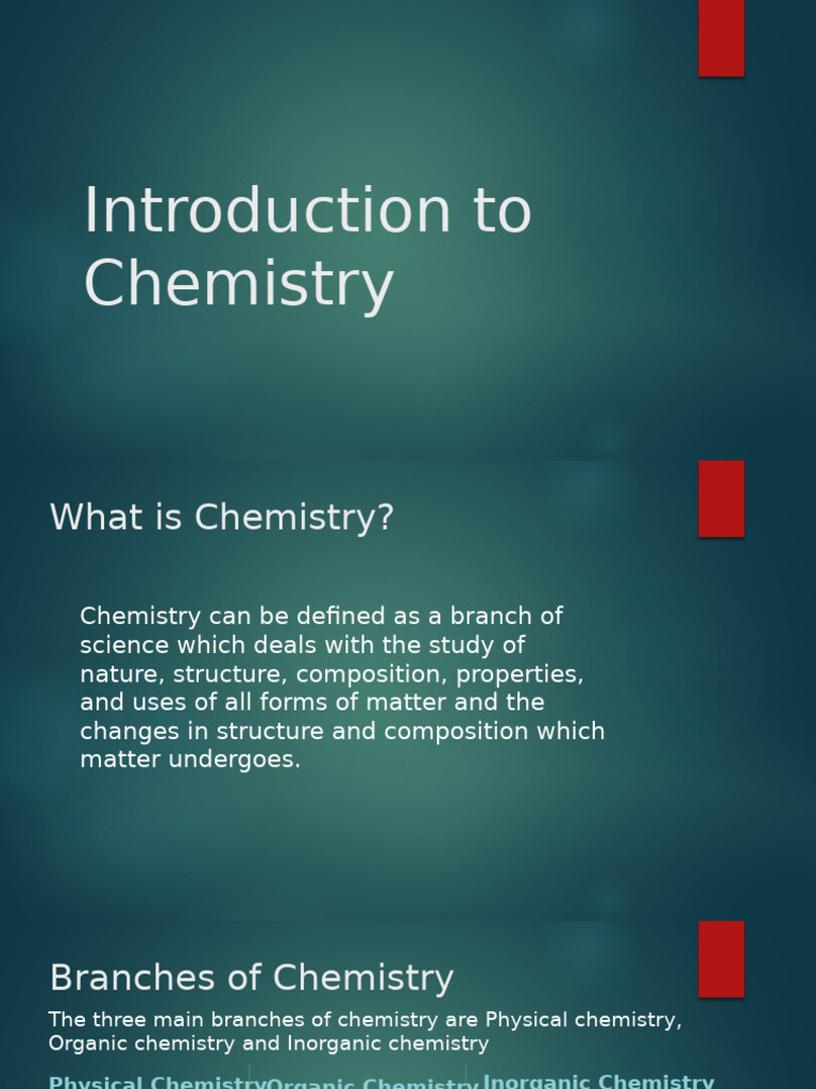
Who doesn’t love memorizing constants? Remember Avogadro’s number: 6.02 × 1023? Yep, that’s the number no one forgets. And the pH formula pH = -log[H3O+]? Sweet and simple.
Some readers even cheekily mention their sharing plans: “Oky, so OP thx, gonna steal this for my next exams hehe.” Others remind us of those starting out: “Anyone else half gets this as they’re just going into year 10?”
Humor aside, this shows the cheat sheet’s broad appeal—novices and slightly advanced learners both find nuggets of value.
Why This Cheat Sheet Stands Out
Most cheat sheets drown you in formulas without context. This one? It’s different. It combines:
- Correct notation and units that keep your calculations legit.
- Tips on algebraic manipulation to unlock formulas easily.
- Emphasis on unit analysis, helping you catch mistakes early.
- Standard condition clarifications that prevent ambiguity.
- Memorable mnemonics to remember chemical symbols and relations.
- Encouragement to internalize, not just memorize—a killer combo for tests and beyond.
And bonus: plenty of friendly, humorous comments make this cheat sheet feel like a conversation with a knowledgeable friend—not some dusty textbook.
Final Thoughts: Grab Your Pen, Not Just Your Calculator
Chemistry can seem intimidating, but a good cheat sheet like this reduces chaos. It teaches you how to think—a life hack for any STEM student. Using precise symbols like M and units like g/mol keeps your work accurate. Mastering algebraic manipulation helps simplify problems quickly. Never ignore the power of unit analysis. It’s your compass through tricky questions.
And remember: encourage yourself. Chemistry isn’t a sprint; it’s a journey. The cheat sheet encourages practice. “Besides the constants, memorize it! Lol. This info will be second nature to you within a year.” Don’t rush. Learn steady and laugh a little.
So, ready to save this cheat sheet for the next exam? How do you plan to make tricky concepts stick? Share your strategies, and maybe toss in your own mnemonic—let’s keep the learning fun and real.
What is the correct symbol and unit for molar mass?
The correct symbol for molar mass is M. Its unit is grams per mole (g/mol), not just grams. Using the right symbol and units ensures formulas make sense.
How can I better manipulate chemical formulas for problem-solving?
Learn to rearrange formulas like A = B × C to isolate unknowns. Practice algebra and unit cancellation to understand formulas rather than just plugging numbers in.
What are common standard conditions I should know instead of SLC?
Most use NTP or STP as standard conditions. Always specify temperature and pressure rather than rely on unclear terms. The ideal gas law pV = nRT helps derive molar volumes.
How can I remember the relationships between chemical variables like m, n, MM, C, and V?
Use triangle diagrams to visualize formulas such as m = n × MM or C1V1 = C2V2. Prefer using C for concentration instead of molarity for clarity.
Why is creating a chemistry cheat sheet valuable?
Organizing study material builds strong life skills. It helps you revise quickly and internalize concepts over time. Regular practice makes the info almost automatic.
Any tips to improve an introductory chemistry cheat sheet?
Be concise and avoid excess white space. Focus on key formulas and understanding processes. Practicing problems deepens knowledge beyond just copying formulas.


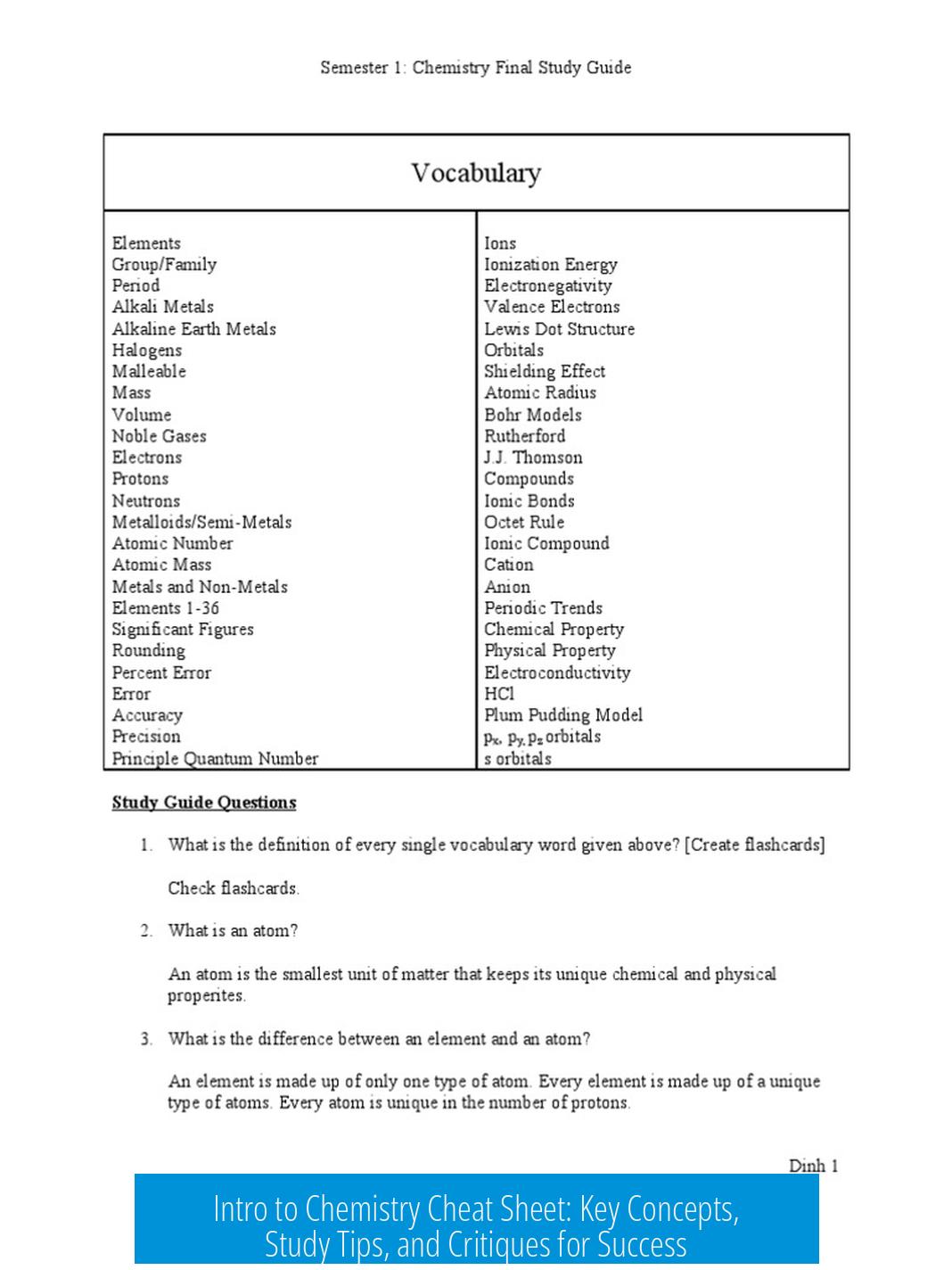

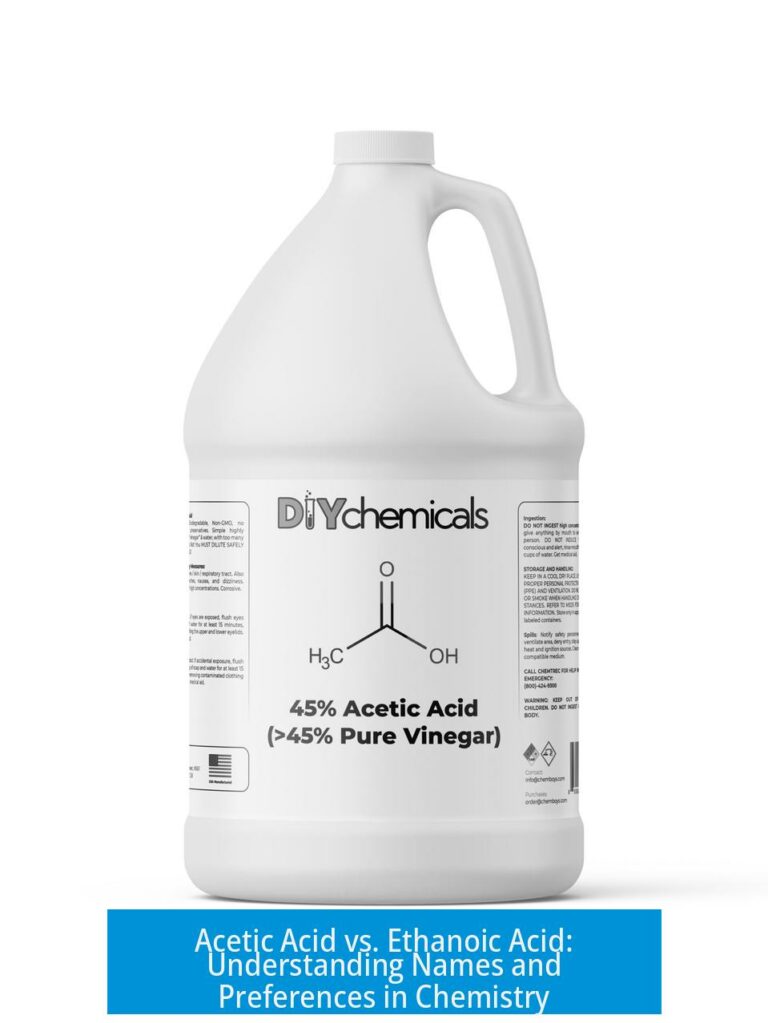
Leave a Comment